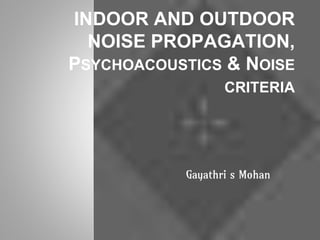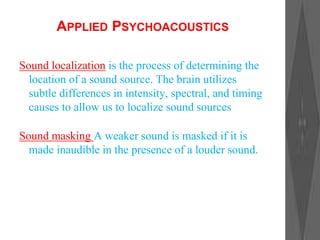Psychoacoustics & Noise criteria
- 1. INDOOR AND OUTDOOR NOISE PROPAGATION, PSYCHOACOUSTICS & NOISE CRITERIA Gayathri s Mohan
- 2. SOUND PROPAGATION OUTDOOR ⦿Sound waves emitted from a point source propagate spherically - equally in all directions - from the source.
- 3. ⦿Outdoors, sound waves travel in a continuously extending spherical wavefront from the source. For a point source that emits a certain sound energy, this energy is concentrated in a single point at the source. At a distance from the source, the same energy is distributed over a sphere. The greater the distance from the source, the larger the surface over which the energy is dispersed. This may be illustrated by studying a segment of the expanding sphere.
- 4. ⦿The sound energy is dispersed over an imaginary sphere with a surface that grows in proportion to the square of the distance from a point source.
- 5. ⦿The surface of the sphere grows 4 times with each doubling of the distance from the source. The sound hence rapidly declines with the distance from the source. Each doubling of the distance from the point source yields a 6 dB reduction of the sound level.
- 6. SOUND PROPAGATION INDOOR ⦿Indoors, the sound wave hits building construction surfaces before it is significantly attenuated. The sound field indoors is not spherical but depends on the geometry and the acoustical properties of these surfaces. The volume of the room and the distances between the sound source, the building construction surfaces and the listening point are also important.
- 7. ⦿The sound in a certain listening point in a room is composed of the direct sound and the reflected sound. The direct sound is the sound that has not yet been reflected in a surface. The sum of all reflected sound is called the reverberent sound field. It consists of all sound that has been reflected once, twice or more in the building construction surfaces. The sound reflected one time is called 1st reflections, two times 2nd reflections etc.
- 8. Two-dimensional sound reflections in a room with only reflecting surfaces.
- 9. ⦿The number of reflections affecting the reverberent sound field depends on the acoustic properties of the surfaces. If the building surfaces were totally sound reflecting, there would theoretically be an infinite number of reflections.
- 10. Two-dimensional sound reflections in a room with one absorbing surface.
- 11. ⦿ If the surfaces were perfectly absorptive, there would be no reflections at all. In reality, there is always a loss of energy when a sound wave hits a wall. The air also absorbs some of the sound wave's energy. The sound absorption is frequency dependent. High frequency sound is often more easily absorbed than low frequency sound.
- 12. PSYCHOACOUSTICS ⦿ Psychoacoustics is the scientific study of sound perception, ie, the branch of science studying the psychological and physiological responses associated with sound including speech and music. ⦿ Hearing includes the mechanical wave propagation and a sensory and perceptual event ⦿ When sound arrives at the ear, it is transformed to neural action potential. ⦿ The ear has a nonlinear response to sounds of different intensity levels; this nonlinear response is called loudness
- 13. NOISE LIMITS ⦿The human ear can nominally hear sounds in the range 20 Hz (0.02 kHz) to 20,000 Hz (20 kHz). ⦿The upper limit tends to decrease with age; most adults are unable to hear above 16 kHz. ⦿Tones between 4 and 16 Hz can be perceived via the body's sense of touch. ⦿The minimum threshold at which a sound can be heard is frequency dependent. By measuring this minimum intensity for testing tones of various frequencies, a frequency dependent absolute threshold of hearing (ATH) curve may be derived and can be used to find the lower limits.
- 14. APPLIED PSYCHOACOUSTICS Sound localization is the process of determining the location of a sound source. The brain utilizes subtle differences in intensity, spectral, and timing causes to allow us to localize sound sources Sound masking A weaker sound is masked if it is made inaudible in the presence of a louder sound.
- 15. NOISE EVALUATION INDICES AND BASIS FOR CRITERIA ⦿To properly evaluate noise exposure, both the type and level of the noise must be characterized. ⦿The type of noise is characterized by its frequency spectrum and its variation as a function of time. The level is characterized by a particular type of measurement which is dependent on the purpose of the measurement
- 16. NOISE CRITERION ⦿The noise criteria (NC) is a single numerical index commonly used to define design goals for the maximum allowable noise in a given space. ⦿Noise Criterion - NC - were established in U.S. for rating indoor noise, noise from air-conditioning equipment etc. Noise Rating Curves – NR are commonly used for noise criteria ⦿Choosing an appropriate noise criteria is important when specifying acceptable levels of noise. ⦿The NC criteria consist of a family of curves that define the maximum allowable octave-band sound pressure level
- 17. NC CURVES ⦿The NC criteria consist of a family of curves that define the maximum allowable octave-band sound pressure level corresponding to a chosen NC design goal. ⦿The method consists of a set of criteria curves extending from 63 to 8000 Hz, and a tangency rating procedure. The criteria curves define the limits of octave band spectra that must not be exceeded to meet occupant acceptance in certain spaces. ⦿The NC rating can be obtained by plotting the octave band levels for a given noise spectrum - the NC curves. The noise spectrum is specified as having a NC rating same as the lowest NC curve which is not exceeded by the spectrum.
- 19. NOISE CRITERIA LEVELS FOR ROOMS Type of Space (and acoustical requirements)NC level Conference rooms, churches, lecture halls, classrooms: NC 30- 35 Open-offices, schools, lobbies, public areas :NC 35-40 Large public offices: NC 40-45 Shops, garages, etc. (for just acceptable speech and telephone communication): NC 50-60 For work spaces where speech or telephone communication is not required,but where there must be no risk of hearing damage: *NC 55-70
- 20. PSYCHOACOUSTIC MODEL ⦿The psychoacoustic model provides for high quality lossy signal compression by describing which parts of a given digital audio signal can be removed (or aggressively compressed) safely — that is, without significant losses in the (consciously) perceived quality of the sound. ⦿compression is a feature of nearly all modern lossy audio compression formats.





















